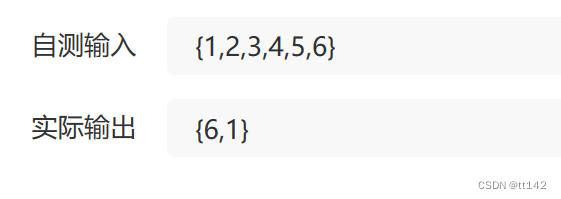【C++】面试101,反转链表及变式,合并链表及变式
迪丽瓦拉
2024-06-03 04:53:38
0次
1.反转链表
- 普通方法
#include
class Solution {
public:ListNode* ReverseList(ListNode* pHead) {ListNode *cur=pHead; //当前指针ListNode * tail=nullptr; //尾指针
ListNode* tmp; //保存指向,防止找不到
while(cur) //一直遍历到链表尾
{ tmp=cur->next; //首先保存下一个位置的指向cur->next=tail; //反转tail=cur; //tail往后走cur=tmp; //cur向后走,不能先写tail=cur要不然cur就丢了}return tail; }
}; - 递归
class Solution {
public:ListNode* ReverseList(ListNode* pHead) {
if(!pHead||!pHead->next) return pHead; //如果节点为空或者next为空 此时的返回值是最后一个节点
ListNode* tail=ReverseList(pHead->next);//tail接收最后一个节点,也就是结果链表的第一个节点
//pHead->next->next=pHead; //pHead->next是尾节点,把当前节点pHead挂到尾节点的后面
//pHead->next=nullptr; //当前节点指向置空
//return tail; //返回反转链表的第一个节点
pHead->next->next=pHead;
pHead->next=nullptr;
return tail;
};
};在第一次归的时候,pHead->next 和 tail是相同的,都是结果链表的头结点,也是反转链表的第一个节点,那么为什么不写成tail->next =pHead 因为tail始终都是结果链表最后一个节点,所以他的next永远都是结果链表第二个节点,写成这样就直接永远输出两个节点

但是写成pHead->next->next,由于pHead在改变,才能正确连接
2. 指定区间的翻转
不知道这个题难度怎么样,我写了很久,最后总结了别人的代码写出我的理解
- 头插入
翻转区间是m=2,n=4,
把cur移动到第二个节点(也就是m位置),同时保存cur前一个节点pre
每次头插的是cur->next
1 2 3 4 5(cur->next=3,把3头插到3 2 4的最前面,其余顺移) ——> 1 3 2 4 5(cur->next=4) ——> 1 4 3 2 5
注意:万一m=1,那么pre需要一个哨兵位安放
ListNode* reverseBetween(ListNode* head, int m, int n) {ListNode* res=new ListNode(-1); //设置哨兵位,防止pre越界res->next=head; //哨兵位和链表连上ListNode* pre=res; ListNode*cur=head;for(int i=1;inext;} //cur在m个节点上,pre是他前一个节点for(int i=m;inext;cur->next=tmp->next;tmp->next=pre->next;pre->next=tmp;}return res->next;}
}; 3.k个一组反转链表
其实k个一组是不是也是指定区间的反转!!!!!
class Solution {
public:/*** * @param head ListNode类 * @param k int整型 * @return ListNode类*/ListNode* reserve(ListNode* head,int m,int n) //m-n区间反转{ListNode* res=new ListNode(-1);res->next=head;ListNode* cur=head;ListNode* pre=res;for(int i=1;inext;}for(int i=m;inext;cur->next=tmp->next;tmp->next=pre->next;pre->next=tmp;}return res->next;}ListNode* reverseKGroup(ListNode* head, int k) { // write code hereif(!head) return head; //空直接返回int m=1,n=k;
ListNode* cur=head;
int size=0; //计算节点个数while(cur){cur=cur->next;size++;} if(k>size) return head; //k比节点总数多直接不反转head= reserve(head,m,n); //肯定反转一次m+=k;n+=k;while(n<=size) //迭代{head= reserve(head,m,n);m+=k;n+=k;}return head;}
}; 4.合并有序链表
直接默写没什么好说的
class Solution {
public:ListNode* Merge(ListNode* pHead1, ListNode* pHead2) {ListNode* cur1=pHead1;ListNode*cur2=pHead2;ListNode* newhead=new ListNode(-1);ListNode* cur=newhead;while(cur1&&cur2){ListNode* tmp1=cur1->next;ListNode*tmp2=cur2->next;if(cur1->valval){cur->next=cur1;cur1=tmp1;}else {cur->next=cur2;cur2=tmp2;}cur=cur->next;}while(cur1){cur->next=cur1;cur=cur->next;cur1=cur1->next;}while(cur2){cur->next=cur2;cur=cur->next;cur2=cur2->next;}return newhead->next;}
};
5.合并k个已排序的链表
感觉看到了之前k个一组反转链表
直接复用
class Solution {
public:ListNode* merge(ListNode*head1,ListNode*head2){ListNode* newhead=new ListNode(-1);ListNode*cur=newhead;ListNode*cur1=head1;ListNode*cur2=head2;while(cur1&&cur2){ListNode*tmp1=cur1;ListNode* tmp2=cur2;if(cur1->valval){cur->next=cur1;cur1=cur1->next;}else{cur->next=cur2;cur2=cur2->next;}cur=cur->next;}while(cur1){cur->next=cur1;cur1=cur1->next;cur=cur->next;}while(cur2){cur->next=cur2;cur2=cur2->next;cur=cur->next;}return newhead->next;}ListNode *mergeKLists(vector &lists) {if(lists.size()==0)return nullptr; ListNode* newhead=lists[0];for(int i=1;i 相关内容
热门资讯
Linux-scheduler...
四、调度域 SDTL结构 linux内核使用SDTL结构体来组织CPU的层次关系 struct sc...
托福口语21天——day5 发...
目录 一、连读纠音 二、语料输入+造句输出 三、真题 一、连读纠音 英语中的连读方式有好几种...